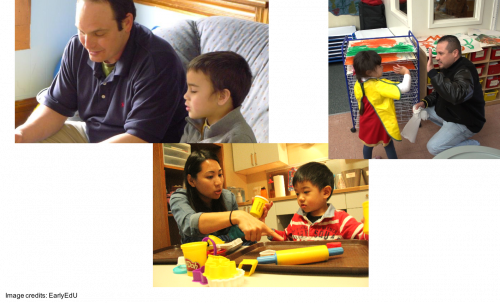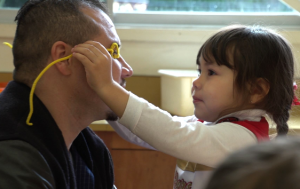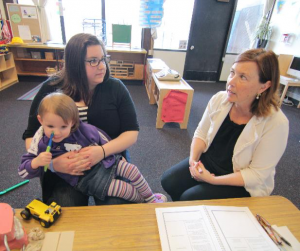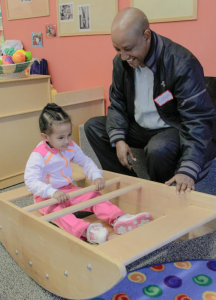12-1 Relationships and Engaging Families
A – Parents As Children’s First Teachers

Parents and families are children’s first and most important teachers. As you have learned throughout this course, children learn so much from caregivers in their earliest days and months of life. Language, social cognition, and the brain are rapidly developing in these early days.
In addition to these foundational skills, parents and families teach children about their unique family history and their culture and customs in a way that no one else can. Although some of this teaching may be explicit, much is implicit and conveyed as families celebrate holidays and enjoy one another’s company.
From the first day of life, parents not only have the opportunity to teach children about the world, but they also are beginning to form strong bonds with their children. Strong early relationships give children the confidence to explore their world and the encouragement to learn new things. These relationships will persist long after formal schooling ends.
Why Engage Families?

Given that children spend so much of their time with parents and families and given that children learn so much in the early years, parents and families are natural partners for educators. But what are some of the specific benefits of engaging families in children’s education?
Researchers have found a variety of positive effects of increased family engagement on children’s learning. For example, children with meaningfully engaged families tend to have fewer behavior problems in school, demonstrate increased motivation and persistence in tasks, have better relationships with their peers, and show better academic preparedness to enter kindergarten.
In addition to these short-term effects, increased parent engagement has been shown to offset the negative academic effects that are often associated with living in a low-income household. Coming from a low-income household has been associated with fewer experiences that might increase skill development and academic success. Research, however, demonstrates that family engagement may override these negative factors. Whereas children from low-income households typically start behind and stay behind their peers from middle- and upper-class households, when families become engaged in children’s education and school, they can eliminate this disadvantage.
Because the effects of family engagement are far-reaching—from children’s behavior in the early learning setting to their attitude toward challenging situations and even their later academic success—family engagement becomes critical for educators. It not only increases the effectiveness of the school environment for each child, but it also creates a better school environment for all children.
 Interactive: Learning in Informal Environments
Interactive: Learning in Informal Environments
This is an interactive! Use the slider to explore the graph.
What is Family Engagement?
Read the definition of family engagement from the Office of Head Start:
“Family engagement is a collaborative and strengths-based process through which early childhood professionals, families, and children build positive and goal-oriented relationships. It is a shared responsibility of families and staff at all levels that requires mutual respect for the roles and strengths each has to offer. Family engagement focuses on culturally and linguistically responsive relationship-building with key family members in a child’s life.”
- What words and phrases are powerful?
- Which ones are surprising?
Video: Supporting Family Engagement (1:54)
This video, Supporting Family Engagement, features a mentor-educator, identified in this video as a technical assistance coordinator.
As you watch, consider how this mentor-educator talks about strategies for engaging families.

Video Debrief
What strategies did this educator mention for engaging families? (click to toggle expand or collapse)
Possible Answer
After watching the video, what strategies did this educator mention for engaging families?
We considered the following as possible responses:
- Learning about families’ passions and struggles.
- Working to make sure families feel welcome, cared for, and loved.
- Preparing families intentionally during enrollment for children’s first day.
- Creating a friendly culture.
B – Building Relationships with Families

Strong relationships with families must be authentic. Both parties need to come together to focus on their common goal—the well-being of the child. In authentic partnerships, both parties are equals, though they may have different areas of expertise.
An important aspect of engaging families is open and honest communication. Invite parents to tell you about their children and to share their effective strategies for encouraging their children’s learning and development—what works and what does not. Being responsive to families’ suggestions lets them know that you are listening and value their opinion.
Through communication, work to build consistency between the early learning program and home. Children thrive and feel safe when they have consistency in their lives. A program’s willingness to build consistency also lets families know that a genuine partnership is valued.
Finally, be sure to create a welcoming environment for families. This means welcoming families into the early learning environment and also accepting families of all backgrounds and cultures.
What’s Special About Fathers?

Fathers are often more involved in child rearing than fathers were in the past. They may prepare meals, read to children, and help with homework.
However, many fathers report that public opinion still considers them a babysitter or temporary caregiver for children instead of an involved parent.
Recent research demonstrates that fathers make important contributions to children’s development. When fathers are more engaged, children have:
- Better language and cognitive skills.
- Increased academic readiness.
- More emotional security.
- Better friendships.
To send a message that fathers are welcome in early learning settings, educators might display photos of both mothers and fathers interacting with children, make sure to talk with both mothers and fathers, and communicate that they recognize fathers as equal in parenting tasks.
Video: Welcoming Families (3:56)
Based on the information on multiculturalism, consider these questions:
- How did the family advocate talk about helping diverse families connect with the program?
- What processes does this program use to make sure families feel welcome?

Video Debrief
What are some ways that the family advocate talks about helping diverse families engage with the program?(click to toggle expand or collapse)
- Families that do not speak English can communicate in their home languages.
- Staff members who share the cultural and linguistic backgrounds of families help with communication.
- Families have opportunities to participate in the early learning program.
What processes does this program use to make sure families feel welcome? (click to toggle expand or collapse)
- Accepting families where they are at
- An orientation, or welcome, meeting
- Invitations to participate in the early learning environment and to meet educators, program staff, and management
- A tour of the building

Reflection Point
Answer the following questions for review:
- What is family engagement and why is it important?
- Name one effect of family engagement on children’s development (hint: there are five possible answers).
- What are two strategies for engaging families in their children’s learning?
C – Using Strengths-Based Approaches
An important part of engaging families is honoring their knowledge, expertise, and contributions. When educators adopt strengths-based approaches with families, the relationship grows.
Strengths-based Attitudes
Strengths-based approaches are grounded in positive attitudes about the families you are working with. These attitudes will inform your opinions, judgments, and behaviors. Some examples of strengths-based attitudes for educators include these from the Office of Head Start’s National Center on Parent, Family, and Community Engagement:
- Families are the first and most important teachers of their children.
- Families are our partners with a critical role in their family’s development.
- Families have expertise about their child and their family.
- Families’ contributions are important and valuable.
Video: Vroom: Everyone Has What It Takes To Be a Brain Builder! (2:10)
This video, produced by Vroom, is based on the idea that parents already have what it takes to be a good parent. It’s an example of a strengths-based approach.
Think about strengths-based approaches based on the information you see in the video.
-
- What is the message for parents?
- How do parents react to the message, and why do you think they react that way?
Watch Everyone Has What it Takes to be a Brain Builder! from Vroom on YouTube.

Video Debrief
What messages did you see? (click to toggle expand or collapse)
Possible Answer
- What was the message for parents? The message is: You already have what it takes.
- How did parents react to the message, and why do you think they reacted that way?
- One possibility is that parents can feel overwhelmed and unprepared for the massive and important task of raising a child.
- After hearing the message, parents felt empowered to know that they already have what they need to support their child.

Reflection Point
Consider the following questions:
- What environmental factors may influence whether parents feel like good parents?
- Describe one strengths-based approach that you use with families in your program.
- Name one more strengths-based approach that you can use in your teaching practice this week.
 References
References
Cultivate Learning (Producer). (2017). Supporting family engagement. University of Washington. [Video File]
Cultivate Learning (Producer). (2018). Welcoming families. University of Washington. [Video File]
Dearing, E., Kreider, H., Simpkins, S., & Weiss, H. B. (2006). Family involvement in school and low-income children’s literacy: Longitudinal associations between and within families. Journal of Educational Psychology, 98(4), 653-664.
Fantuzzo, J., McWayne, C. M., Perry, M.A., & Childs, S. (2004). Multiple dimensions of family involvement and their relations to behavioral and learning competencies for urban, low-income children. School Psychology Review, 33(4), 467-480.
McWayne, C. M., Hahs-Vaughn, D.L., Cheung, K., & Wright, L.E. (2012). National profiles of school readiness skills for Head Start children: An investigation of stability and change. Early Childhood Research Quarterly, 27(4), 668-683.
Stevens, R., Bransford, J., & Stevens, A. (2005). The LIFE Center’s lifelong and lifewide diagram. [Website]
U.S. Department of Health and Human Services, Administration for Children and Families, Office of Head Start. (n.d.). Family engagement. [Website]
U.S. Department of Health and Human Services, Administration for Children and Families, Office of Head Start, National Center on Parent, Family, and Community Engagement. (n.d.). Building partnerships: Guide to developing relationships with families. [PDF]
Vroom. (2015, March 15). Vroom: Everyone has what it takes to be a brain builder. [Video]
EarlyEdU Alliance (Publisher). (2018). 12-1 Relationships and engaging families. In Child Development: Brain Building Course Book. University of Washington. [UW Pressbooks]

